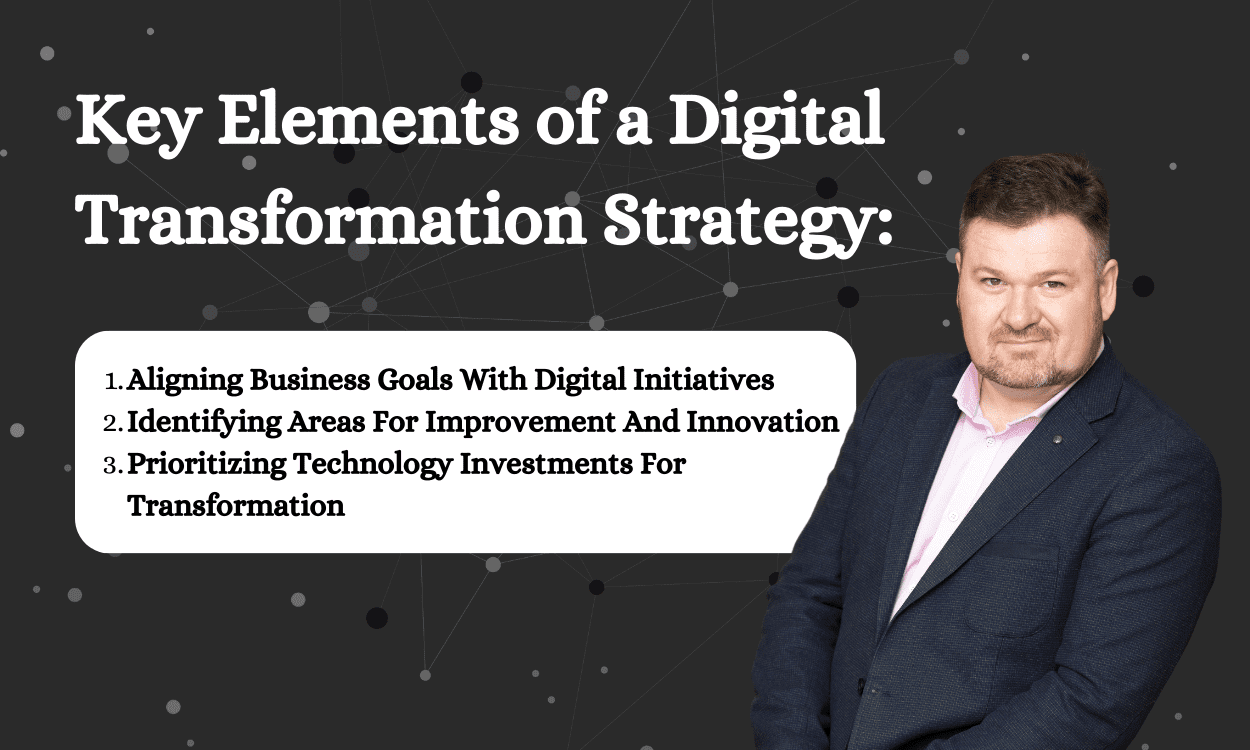
Crafting a Winning Digital Transformation Strategy for 2024
Developing a digital transformation strategy is essential for businesses to stay competitive in the modern marketplace. This strategy integrates technologies like artificial intelligence (AI), machine learning, and cloud computing into business operations. As we begin 2024, embracing these technologies is crucial to enhance efficiency and improve customer experiences. Crafting a digital transformation strategy requires understanding how to effectively apply current technological trends within your business context, adapting business models and strategies to leverage these digital advancements for sustainable growth.


What is digital transformation?
What do we mean when we talk about digital transformation? Let’s simplify this concept to make it more digestible.
Definition of Digital Transformation
At the most basic level, digital transformation refers to adopting and integrating digital technology into all business areas. This shift fundamentally alters how you operate and deliver value to customers. According to McKinsey, this phenomenon is about more than changing an isolated domain; it involves a comprehensive remodeling of entire businesses and their corporate cultures.
It’s about finding new ways to solve old problems, leading to results that weren’t feasible before. Crucially, it’s also about anticipating trends instead of merely reacting—driving disruptive change rather than falling victim to it.
Examples of Digital Transformation in Businesses
Let’s explore a few examples to complement the definition with real-world context.
- Netflix: Initially starting as a mail-order DVD rental service, Netflix recognized early on the potential impact the internet could have on their business model. They redefined themselves completely by transitioning into online streaming—a perfect example of how foresight can ease digital transformation.
- Domino’s Pizza: Beginning as a humble pizza chain, Domino’s became “an e-commerce company that sells pizza.” By prioritizing tech investments for developing online ordering systems, mobile apps, and social media engagement strategies, they radically enhanced customer experiences.
- Adobe Systems: Adobe made the tough decision to move from selling packaged software (like Photoshop) towards cloud-based subscriptions for its services. The decision was risky but successful, and Adobe continues to thrive as it adapts to market dynamics.
- General Electric (GE): To compete in the age of IoT (Internet of Things), GE created a new market for the Industrial Internet aimed at connecting machines, analytics, and people. Their transformation aimed to maximize efficiency across different sectors by leveraging digital technology.
These examples illustrate how broad-ranging and impactful digital transformation can be. Understanding this dynamic concept is the first step toward crafting your winning strategy in 2024. Will your business follow in their footsteps? We’ll delve deeper into this in upcoming sections.

Why does digital transformation matter?
In the current business landscape, going digital is not an option—it’s a necessity. But why is it given such paramount importance? Let’s delve deeper and uncover the reasons behind digital’s ever-growing influence.
Impact of Digital Transformation on Business Success
Digital transformation significantly boosts business success in multiple ways. Firstly, it cultivates operational efficiency by automating tasks, speeding up processes, and breaking down silos among different departments. With streamlined operations, businesses can quickly respond to changes and compete efficiently, even when market dynamics continuously evolve.
Secondly, it helps attract and retain customers in today’s digitally savvy market. By embracing digital channels, companies can craft personalized interactions that foster loyalty and enhance user experience, thus profoundly impacting customer satisfaction.
Thirdly, this dynamic shift fuels data-driven decision-making. With actionable insights upon adopting analytics and Big Data technologies, leaders make well-informed decisions underpinning growth direction.
Lastly is innovation—digital transformation fosters a culture of creativity and agility, enabling businesses to pivot smoothly toward new opportunities while mitigating risks effectively.
Benefits of Implementing a Digital Transformation Strategy
For businesses contemplating whether to leap into the “digital” world or not – here are three convincing benefits to keep in mind:
- Improved Customer Experience: Today’s tech-savvy consumers desire swift, seamless transactions at their fingertips. Leveraging technologies like AI & Machine Learning for predictive analytics ensures highly personalized experiences build trust.
- Increased Operational Efficiency: From automated workflows to AI-enabled quality checks, streamlining reduces resource waste dramatically while amplifying output capabilities ensuring efficient utilization of time and manpower.
- Enhanced Competitive Advantage: A solid digital presence reinforces brand perception as competition increases and markets grow. This helps you gain a leading edge in your industry niche and improve customer reach.

Key Elements of a Digital Transformation Strategy
As we dive into the depth of digital transformation strategy, it’s crucial to recognize its significant components. Three key elements are aligning business goals with digital initiatives, identifying improvement and innovation areas, and designing technology investment priorities.
Aligning Business Goals With Digital Initiatives
All great strategies start by defining the end goal, don’t they? Similarly, aligning your company’s business objectives with digital avenues is pivotal in crafting an excellent digital transformation path.
Simply incorporating high-tech solutions without any specific purpose will not yield successful outcomes. As rightly predicted by Deloitte in a list of transformative tech trends, “cloud as an innovation driver” plays a leading role in government organizations’ advancements.
To improve their IT usage while promoting innovation, organizations must ensure that their overall goals and specific objectives are closely linked with every technological advancement they adopt. Doing so will ensure that each digital development significantly impacts increasing efficiency and enhancing the user experience.
Identifying Areas For Improvement And Innovation
Once you have established the bond between your corporate aspirations and digitization expeditions, the second step is diagnosing deficiencies and spotting possibilities of creativity within your enterprise systems.
Your daily routine practices may sustain your current performance, but to soar higher than your rivals, constantly seeking improvements is a must-do exercise. Rigorous analysis can reveal gaps waiting to be filled by unique explorations. Remember how spending 70 to 80 percent on maintaining legacy IT structures leaves businesses with scarce budgets for exploring new opportunities or enhancing attributes?
This insight from the Enterprisers Project demonstrates the need to conduct regular assessments to make compelling room for breakthrough progress instead of just bloating up historical records.
Prioritizing Technology Investments For Transformation
The most compelling part of a digital transformation strategy is setting your spending priorities. Even though all hot-in-the-market technologies might appear tempting to you, wise would be to avoid falling into the trap.
Gauge your needs. Evaluate your capabilities. And then, decide which tech tools suit your organization’s temperament the best. It could be augmenting AI-powered decision-making and forecasting solutions or switching entirely to AR/VR-fueled customer engagement drives, depending on your industry type, market state, economic health, and patient returns anticipation.
In summary, understanding and adopting these three critical elements form the backbone of sculpting that winning digital transformation strategy for 2024 you are aiming for!
Need Some Cyber Support?
Conclusion
In conclusion, the journey towards a successful digital transformation strategy in 2024 involves more than just adopting new technologies; it’s about a holistic reimagining of business operations and culture. By aligning business goals with digital initiatives, identifying areas for improvement, and prioritizing technology investments, businesses can stay competitive and responsive to rapidly changing market demands. Embrace this transformative journey with a clear vision and strategy, and remember that digital transformation is a continuous process of evolution, not just a one-time change. Stay ahead of the curve and ensure your business is ready for the future.

